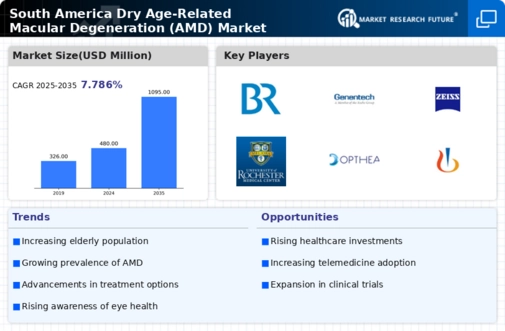The South America Dry Age-Related Macular Degeneration (AMD) Market presents a dynamic and competitive landscape characterized by various players striving to address the growing prevalence of AMD in the region. Market insights reveal that several companies are focusing on enhancing treatment options through innovative research and development efforts. As the population ages and awareness about eye health increases, demand for effective solutions to manage AMD is expected to rise significantly. This trend drives companies to create specialized products targeting AMD management, incorporating advanced technology and novel therapeutics.
The competition is not only among pharmaceutical giants but also includes emerging firms seeking to carve a niche in this vital therapeutic area. Companies involved in this market are compelled to improve their service delivery, product effectiveness, and patient outcomes to maintain a competitive edge.Bayer has positioned itself as a strong player in the South America Dry Age-Related Macular Degeneration (AMD) Market, driven by its commitment to research and development as well as its robust marketing strategies. The company's expertise in ophthalmology is reflected in its innovative product offerings tailored to meet the specific needs of the South American demographic.
Bayer's established presence in the region allows for a more profound understanding of local healthcare practices and regulatory frameworks. With a well-distributed network and partnerships with healthcare providers, Bayer ensures that its treatments reach patients effectively. The company's focus on patient education and awareness campaigns further strengthens its position in the market, enabling them to connect better with the communities they serve.Genentech, recognized for its pioneer work in biopharmaceuticals, has made significant inroads into the South America Dry Age-Related Macular Degeneration (AMD) Market. The company's emphasis on groundbreaking therapies, particularly in areas of retinal diseases, positions it favorably against competitors.
Genentech's portfolio includes key products designed specifically for AMD management, which enhance patient outcomes while focusing on safety and efficacy. The company's presence is bolstered by strategic mergers and acquisitions that expand its capabilities and enhance its research infrastructure within the region. By leveraging local partnerships and relationships with health providers, Genentech ensures that its offerings are accessible to patients in South America, thereby improving health outcomes. Their commitment to understanding regional medical needs drives the development of targeted therapies that reflect the evolving landscape of AMD treatment in South America.









